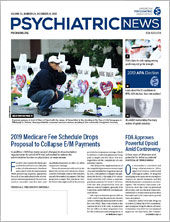For 2019, the Centers for Medicare and Medicaid Services (CMS) has reduced administrative burdens associated with documentation while preserving separate payments for each of the individual levels of evaluation and management (E/M) services used to describe care for new and established patients in office or other outpatient settings.
Those decisions are reflected in the final rule on the 2019 Medicare Physician Fee Schedule, which CMS released in early November. In August, CMS had proposed a single “flat payment rate” for level 2 through level 5 E/M services provided in outpatient settings, which would have resulted in physicians being paid a single rate for those services regardless of the complexity of care patients require.
CMS delayed the implementation of the simplified payment structure until 2021 and modified its original proposal. In 2021, CMS plans to collapse the payment for levels 2 through 4 for outpatient visits but will retain a separate payment amount for level 5 services. CMS has also proposed for 2021 an add-on code for complex, specialty E/M visits that can be billed by psychiatrists and others.
APA expects that this special add-on code could bring the payment amount closer to what psychiatrists now receive for code 99214. That code, which is the current level 4 E/M code, is indicated for an “office or other outpatient visit for the evaluation and management of an established patient, which requires at least two of the following three key components: a detailed history, a detailed examination, and medical decision making of moderate complexity.”
In the meantime, CMS has adopted several of the documentation changes for which APA had advocated in comments it submitted on the proposed rule. Beginning on January 1, 2019, CMS will no longer require physicians to document medical necessity for treating patients in their home rather than in the office; will no longer require physicians to re-record history and exam elements for established patients when there is documentation that those items have been reviewed and updated; and will allow physicians to indicate they have reviewed and verified information that is already recorded by ancillary staff or the patient regarding the patient’s chief complaint and history.
Physicians should continue using either the 1995 or 1997 guidelines for documentation and E/M code selection.
Jeremy Musher, M.D., APA’s advisor to the Current Procedural Terminology (CPT) Panel and RVS Update Committee, said the effect of the collapsed payment for levels 2 through 4 E/M visits will be highly variable, depending on the patient mix and level of care that patients require.
“APA is working collaboratively with other physician organizations and coalitions, including the AMA, to understand the impact of what has been proposed for 2021 and provide thoughtful recommendations to the administration,” Musher said. “The common, consistent theme among the physician organizations has been to ensure that all patients have access to appropriate care and that physicians are paid appropriately for their work.”
As an outgrowth of the SUPPORT for Patients and Communities Act (that is, the “opioid bill/package”), the final fee schedule waives certain rules regarding the location that Medicare beneficiaries must go to receive telehealth services for a substance use disorder or a substance use disorder and a co-occurring mental illness. These changes will allow patients to be seen in their home regardless of whether they are in a federally designated rural area, whereas previously they would have had to go to a qualified “originating site,” such as a hospital or physician’s office, for telehealth services. These new rules go into effect July 1, 2019.
APA strongly advocated for this change and will continue to support the waiver of restrictions that apply only to patients receiving care for mental illness or substance use disorders.
The fee schedule also includes important changes to requirements regarding electronic health records, the Merit-Based Incentive Payment System (MIPS), and the use of quality measures. The following are some of the most important updates in the fee schedule (see box for updates on quality measures):
•
The Advancing Care Information performance category of MIPS has been renamed Promoting Interoperability.
•
Many burdensome measures that required patients to interact with their record have been eliminated.
•
Clinicians must now report to two different public health agencies or clinical data registries. APA’s PsychPRO registry counts as one of them.
•
Two new measures focusing on opioid prescribing are included as potential bonuses for the 2019 reporting year.
MIPS is the government’s payment system that seeks to reward physicians for the value—as opposed to the volume—of services they provide. For 2019, the low-volume threshold has been revised so that physicians will be exempt from MIPS reporting under these conditions:
•
They have allowed charges for covered professional services less than or equal to $90,000.
•
They provide covered professional services to 200 or fewer Medicare Part B-enrolled individuals.
•
They provide 200 or fewer covered professional services to Medicare Part B-enrolled individuals.
Physicians will have the choice of opting in to MIPS reporting if they meet or exceed one or two (but not all three) of the low-volume threshold criteria. Finally, the MIPS Cost category will count as 15 percent of a physician’s overall score in performance year 2019. (The cost category weighs the cost of services provided by a physician compared with peer physicians providing similar services.) ■
Information about the fee schedule can be accessed
here. Members who have questions can email APA at
[email protected] or call the Practice Management Helpline at (800) 343-4671. A summary of the fee schedule is posted on
APA’s website.
